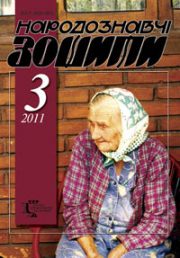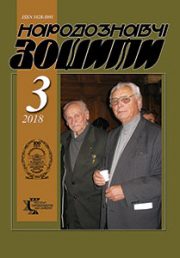The Ethnology Notebooks. 2018, 2 (140), 514—522.
UDK 75.021.335(476)
DOI https://doi.org/10.15407/nz2018.02.514
Received 1.02.2018
Flikop-Svito Halina, candidate of arts (Ph. D)
researcher, State Scientific Institution
“Center of Studies of Belarusian Culture, Language and Literature
of the National Academy of Sciences of Belorussia”.
1 Surganov str., bldg. 2, Minsk, 220072, Belarus
Abstrakt. Icon painting on glass to date is not studied topic in the history of Belarusian art. Preserved an isolated artifacts are the object of study not previously performed. This article discusses five icons on glass from the collections of three museums and a private collection — this is all that was able to identify. In our opinion, these works were created in the 1920—1930-s years. In addition, the materials from archival sources revealed the earliest periods of the spread of icons on glass in the Belarusian lands. It is established that in the second half of the 18th — beginning of 19th centuries in the Uniate churches from different regions met such works.
Keywords: icons on glass, home icons, folk art, painting on glass, art of Belarus of the beginning of the 20th century.
REFERENCES
BGMNAB. KP 15020. Ramka dlja fotografii; nachalo XX v., steklo, rospis’, fol’ga; 20 h 15,5; iz Minska [ in Belarus].
VKM. KP 9143. Ikona «Iisus Hristos», nach. XX v.; steklo, rospis’, fol’ga; 30 h 20,5; d. Makarichi Vilejskogo r-na Minskoj obl. [ in Belarus].
VKM. KP 9588/1. Ramka dlja fotografii, 1950-e gg.; steklo, fol’ga, rospis’; 24,5 h 14,5 sm; iz d. Kobuzi, Vilejskij r-n Minskoj obl. [ in Belarus].
VKM. KP 9588/2. Ramka dlja fotografii, 1950-e gg.; steklo, fol’ga, rospis’; 24,5 h 14,5 sm; iz d. Kobuzi, Vilejskij r-n Minskoj obl. [ in Belarus].
GGMIR. KP 16516. Ikona «Bogorodica s mladencem»; steklo, rospis’, fol’ga; 35,4 h 30,9 sm; hutor Dorogljany Mostovskogo r-na Grodnenskoj obl., k. XІX — nach. XX vv. [ in Belarus].
NIAB. F. 136. Op. 1. D. 8472. Delo o nepisanii i neprodazhe neiskussno pisannyh ikon i o nadzore za ikonopiscami. 1830 g. 10 l. [ in Belarus].
NIAB. F. 136. Op. 1. D. 41256. Akt wizyty duchowienstwa metropolitalniey Wilenskiey Rzymsko-Unitskiey dyecezyi za 1819 rok poszodzone. 740 l. [ in Belarus].
NIAB. F. 1245. Op. 1. D. 1. Akta wizyty generalney surrogacyi Poleskiey dekanatu Rohachew¬skiego. 1792. 29 l. [ in Belarus].
NIAB. F. 1299. Op. 1. D. 1. Akt wizyty generalney surrogacyi Poleskiey dekanatu Hіuskiego. 1792. 31 l. [ in Belarus].
NIAB. F. 1781. Op. 26. D. 1410. Wizyty dekanatуw: Witebskiego, Wieliїskiego, Wielaszkowskiego, Mikulinskiego i Zadz’wiсsko-Bieszenkowskiego za rok 1822. 224 l. [ in Belarus].
NIAB. F. 3245. Op. 8. D. 2. Inwentarze cerkwi dekanatu Borisowskiego. 1741—1754. 40 l. [ in Belarus].
RGIA. F. 824. Op. 2. D. 182. Wizyty dekanatуw Mscisіawskiego, Zapolaсskiego i Zasoїskiego protopresbyteryi Mscisіawskiey za rok 1822. 177 l. [ in Belarus].
RGIA. F. 824. Op. 2. D. 184. Wizyty dekanatow Rohaczewskiego i Homelskiego za rok 1822. 171 l. [ in Belarus].
LMAB. RP. F. 41. 107—212. Inwentarze y wizyty powiatu Wileyskiego. 1787—1826. [in Polish].
LMAB. RP. F. 41. 225—394. Wizyta generalna dekanatьw Brzeskiego, Bialskiego, Mielnickiego, Drogickiego, Bielskiego dyecezyi Brzeskiey [in Polish].
LVIA. — F. 634. — Ap. 1. — B. 48. Wizyta generalna dekanatьw Pruїaсskiego, Kobryсskiego, Poliskiego, Kamienieckiego, Wіodawskiego dyecezyi Brzeskiey [in Polish].
LVIA. F. 634. Ap. 1. B. 50. Wizyta dekanatu Brzeskiego [in Polish].
LVIA. F. 634. Ap. 1. B. 53. Akta wizyty generalnye… dekanatow Sіonimskiego y Lidzkiego [in Polish].
VUB. RP. F. 4. (А195) 14430. Wizyty Ostrowskiey Cerkwi [in Polish].
VUB. RP. F. 4. (А195) 14431. Wizyty Ostrowskiey Cerkwi [in Polish].
VUB. RP. F. 4. (А195) 14432. Wizyty Ostrowskiey Cerkwi [in Polish].
VUB. RP. F. 4. (А195) 14436. Wizyty Ostrowskiey Cerkwi [in Polish].
VUB. RP. F. 4. 20225 (A-439). Inwentarz klasztoru… w Lawryszewie [in Polish].
VUB. RP. F. 4. 35674 (A-2314). Inwentary klasztoru… w Lawryszewie [in Polish].
Romaniv-Triska, O. (uporiad.). (2008). Narodna ikona na skli. Al’bom. L’viv: Instytut kolektsionerstva ukrains’kykh mystets’kykh pam’iatok pry NTSh [in Ukrainian].
Pradmety djekoru tradycyjnaga zhyllja: maljunkі na shkle. Sa zboraў Be-laruskaga dzjarzhaўnaga muzeja narodnaj arhіtjektury і pobytu: katalog vystaўkі. (2011). In Bartkova, M. (skladal’nіk і aўtar ustupnaga slova) & Sahuta Ja. (navukovy daradchyk). Belaruskі dzjarzhaўny muzej narodnaj arhіtjektury і pobytu. Mіnsk: NBB [ in Belarus].
Sahuta, Ja.M. (1989). Razmaljoўka. In Shamjakіn І.P. (Ed.). Jetngrafіja Belarusі: Jencykl. Mіnsk: BelSJe [ in Belarus].
Triska, O. (2014). Kolektsiia ikon na skli z Natsional’noho muzeiu u L’vovi im. Andreia Sheptyts’koho. Narodoznavchi zoshyty, 6 (120), 1355—1368 [in Ukrainian].
Flіkop, G.A. (2014). Abrazy «na shkle» і «za shklom» u grjeka-katalіckіh hramah Belarusі ў XVIIІ — pachatku XІX stst. In Lakotka. A.І. (Ed.). & Bunkevіch N.S. (uklad.). Tradycyі і suchasny stan kul‘tury і mastactvaў: matjer. Mіzhnar. navuk.-prakt. kanfcyі (28—9.11.2013 g., g. Mіnsk): u 2-h ch. (Ch. 1, pp. 200—205). Mіnsk: Prava і jekanomіka [ in Belarus].
Flіkop, G.A. (2014). Belaruskіja ўnіjackіja abrazy Bozhaj Macі «nevjadomaj іkanagrafіі»: da pytannja ўsta¬naўlennja zvodu. Belaruskі gіstarychny chasopіs, 3, 23—37 [ in Belarus].
Belaruskіja muzeі rassakrjecіlі svae fondy ў Magіljove. Retrieved from: http://gorad.by/by/page/leisure/5300/.
Maljunkі na shkle. Retrieved from: http://www.kimpress.by/index.phtml? id=6124&page=2.
Chajkoўskaja, V. Jak patrapіc’ u raj. Retrieved from: http://news.21.by/society/2012/03/07/477960.html.







